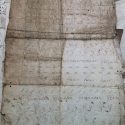There should be no need to mention in a blog about early American history that the digital turn is, perhaps, a fait accompli. However, over the past couple of years more and more articles have called into question the ways in which access to digital archives and digitized sources has changed both the questions historians ask and the kinds of research we do. Of this surge in publications, Lara Putnam’s recent AHR article stands out as a kind of canary-in-the-coal-mine warning to both graduate students and established professionals. Putnam, professor of history at the University of Pittsburgh, calls on all of us to have an “extensive discussion of digitization,” thereby pulling our research approaches out of, “the realm of invisible methods, the black box where by consensus we leave so much of our discipline’s heavy lifting.”[1] For Putnam and others, the digital turn remains full of pitfalls that deserve our serious consideration.
For many of us, the warnings in Putnam’s article come as no surprise – keyword searching limits our available material to that which has been printed, lack of experience reading through local archives means that graduate students lack the on-the-ground expertise that comes from extensive field work, and the playing field of digital scholarship is dangerously skewed towards wealthy institutions that provide access to the most databases. There was one warning, however, that struck me as surprising and made me think about how different seventeenth century research is in comparison with, say, the nineteenth or twentieth century. Putnam explained that we are in danger of producing “a desk discipline” in which graduate students and scholars alike produce manuscripts without ever stepping foot into an archive.
Source: Editor’s Choice: Love Letters and the Digital Turn « The Junto

